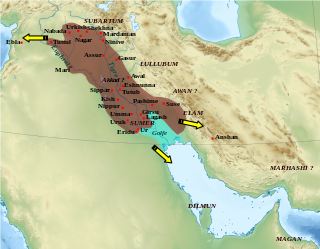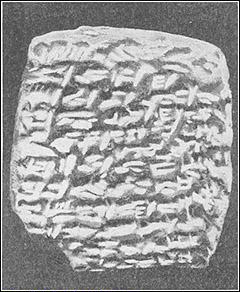Surata was the Ruler of Akka (Akko; Acre, Israel) during the Amarna Period in the Late Bronze Age.
Surata was the Ruler of Akka (Akko; Acre, Israel) during the Amarna Period in the Late Bronze Age.
He ruled the city of Akko during the Amarna Period in the reigns of Akhenaten and Tutankhamen. In letters he refer to himself with the title LU (Man, Petty King) which is subordinate to LUGAL (Big Man, Great King).
Surata is mentioned in Amarna Letters from Akko (EA 232), Byblos (EA 085), Gath (EA 366), and Megiddo (EA 245). [1]
Amarna Letter EA 232 was written by Surata to the King of Egypt (unnamed). In this letter he is just trying to flatter the king.
In Amarna Letter EA 245, he is known for letting the rebel Labaya of Shechem go in exchange for silver. Also mentioned is Yasdata (EA 245, EA 248).
In Amarna Letter EA 366, Suwardata of Gath informs the King of Egypt (unnamed) of hostilities against the habiru. Ir-Heba, Surata of Akko and Intaruta of Aksapa came with 50 chariots to aid.
Surata of Akko was succeeded by Satatna (EA 233, EA 234, EA 235+EA327).

Achshaph was a royal city of the Canaanites, in the north of Canaan. The name means "sorcery".

The Amarna letters are an archive, written on clay tablets, primarily consisting of diplomatic correspondence between the Egyptian administration and its representatives in Canaan and Amurru, or neighboring kingdom leaders, during the New Kingdom, spanning a period of no more than thirty years in the middle 14th century BC. The letters were found in Upper Egypt at el-Amarna, the modern name for the ancient Egyptian capital of Akhetaten, founded by pharaoh Akhenaten during the Eighteenth Dynasty of Egypt.

The land of Subartu or Subar is mentioned in Bronze Age literature. The name also appears as Subari in the Amarna letters, and, in the form Šbr, in Ugarit.

Labaya was the ruler of Shechem and warlord in the central hill country of southern Canaan during the Amarna Period. He lived contemporaneously with Pharaoh Akhenaten. Labaya is mentioned in several of the Amarna Letters. He is the author of letters EA 252–54.

Abdi-Ḫeba was a local chieftain of Jerusalem during the Amarna period. Egyptian documents have him deny he was a mayor (ḫazānu) and assert he is a soldier (we'w), the implication being he was the son of a local chief sent to Egypt to receive military training there.

Rib-Hadda was king of Byblos during the mid fourteenth century BCE. He is the author of some sixty of the Amarna letters all to Akhenaten. His name is Akkadian in form and may invoke the Northwest Semitic god Hadad, though his letters invoke only Ba'alat Gubla, the "Lady of Byblos".
Mutbaal was a Canaanite king of the Amarna Period. He is identified in the Amarna letters as a son of Labaya, the ruler of the hill country north of Jerusalem, including the territory in the vicinity of the city of Shachmu.

Biridiya was the ruler of Megiddo, northern part of the southern Levant, in the 14th century BC. At the time Megiddo was a city-state submitting to the Egyptian Empire. He is part of the intrigues surrounding the rebel Labaya of Shechem.

The Pitati were a contingent of Nubian archers of ancient Egypt that were often requested and dispatched to support Egyptian vassals in Canaan. They are recorded in the correspondence of the 1350 BC Amarna letters, and were often requested to defend against the Habiru, also rogue vassal-kings and foreign troops of neighboring kingdoms, who were on the attack.
Šuwardata (Shuwardata), also Šuardatu, is understood by most scholars to be the king of the Canaanite city of Gath, although some have suggested that he was the 'mayor' of Qiltu, during the 1350-1335 BC Amarna letters correspondence. Šuwardata was the author of 8 letters to the Egyptian pharaoh.
Milki-ilu of Gezer, was the mayor/ruler of the Land of Gazru (Gezer) around 1350 BC. He is known as the son-in-law of Tagi of Ginti-Kirmil and cooperating with Labaya of Shechem, during a period of turmoil among the vassals of Egypt. He is accused of being a rebel, employing mercenaries from the Habiru men.

Tunip was a city-state along the Orontes River in western Syria in the Late Bronze Age. It was large enough to be an urban center, but too small to be a dominant regional power. It was under the influence of various factions like the Mitanni, Egyptians, and Hittites.
Rubutu was a city, or city-state located in ancient northern Israel, between the city of Gazru-(modern Gezer), and Jerusalem during the time of the Amarna letters correspondence, a 15-20 year period at about 1350-1335 BC. Some scholars place Rubutu near present-day Arrabah in the northern West Bank.
Satatna was the ruler of the city-state of Akko around 1350 BC. At the time the city was a vassal of Egypt.
Hannathon or Hinnatuna was a city-state in Canaan during the Late Bronze Age. It is most likely identical with the archaelogical site Tel Hanaton.

Tel Hanaton is an archaeological tell situated at the western edge of the Beit Netofa Valley, in the western Lower Galilee region of Israel, 2 km south of the Town of Kfar Manda and 1 km northeast of the kibbutz which took its name, Hanaton.

Amarna letter EA 282 is a relatively short ovate clay tablet Amarna letter, located in the British Museum, no. 29851.

Amarna letter EA 362, titled: "A Commissioner Murdered," is a finely-inscribed clay tablet letter from Rib-Haddi, the mayor/'man' of the city of Byblos,. Byblos, being a large coastal seaport Mediterranean city, was a city that was aligned with Egypt (Miṣri), and housed an Egyptian community. Rib-Haddi, as the city-state leader wrote the largest number of letters to the Pharaoh, in a sub-corpus of the 1350 BC Amarna letters.

Amarna letter EA 245, titled: "Assignment of Guilt," is a medium length clay tablet Amarna letter from Biridiya the governor-'mayor' of Magidda. It is letter number four of five from Biridiya.
Amarna letter EA 366 is from the king of Gath (Šuwardata) to the king of Egypt. The letter reports of the king having smote down the uprising of the Habiru.